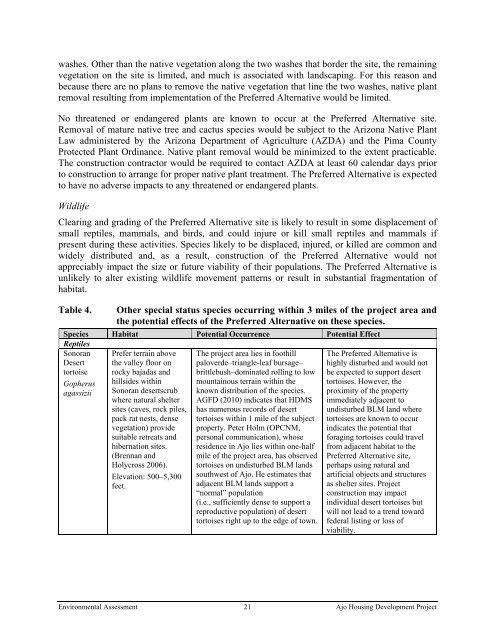US Customs and Border Protection Ajo Housing Development ... - GSA
US Customs and Border Protection Ajo Housing Development ... - GSA
US Customs and Border Protection Ajo Housing Development ... - GSA
Create successful ePaper yourself
Turn your PDF publications into a flip-book with our unique Google optimized e-Paper software.
washes. Other than the native vegetation along the two washes that border the site, the remaining<br />
vegetation on the site is limited, <strong>and</strong> much is associated with l<strong>and</strong>scaping. For this reason <strong>and</strong><br />
because there are no plans to remove the native vegetation that line the two washes, native plant<br />
removal resulting from implementation of the Preferred Alternative would be limited.<br />
No threatened or endangered plants are known to occur at the Preferred Alternative site.<br />
Removal of mature native tree <strong>and</strong> cactus species would be subject to the Arizona Native Plant<br />
Law administered by the Arizona Department of Agriculture (AZDA) <strong>and</strong> the Pima County<br />
Protected Plant Ordinance. Native plant removal would be minimized to the extent practicable.<br />
The construction contractor would be required to contact AZDA at least 60 calendar days prior<br />
to construction to arrange for proper native plant treatment. The Preferred Alternative is expected<br />
to have no adverse impacts to any threatened or endangered plants.<br />
Wildlife<br />
Clearing <strong>and</strong> grading of the Preferred Alternative site is likely to result in some displacement of<br />
small reptiles, mammals, <strong>and</strong> birds, <strong>and</strong> could injure or kill small reptiles <strong>and</strong> mammals if<br />
present during these activities. Species likely to be displaced, injured, or killed are common <strong>and</strong><br />
widely distributed <strong>and</strong>, as a result, construction of the Preferred Alternative would not<br />
appreciably impact the size or future viability of their populations. The Preferred Alternative is<br />
unlikely to alter existing wildlife movement patterns or result in substantial fragmentation of<br />
habitat.<br />
Table 4.<br />
Other special status species occurring within 3 miles of the project area <strong>and</strong><br />
the potential effects of the Preferred Alternative on these species.<br />
Species Habitat Potential Occurrence Potential Effect<br />
Reptiles<br />
Sonoran<br />
Desert<br />
tortoise<br />
Gopherus<br />
agassizii<br />
Prefer terrain above<br />
the valley floor on<br />
rocky bajadas <strong>and</strong><br />
hillsides within<br />
Sonoran desertscrub<br />
where natural shelter<br />
sites (caves, rock piles,<br />
pack rat nests, dense<br />
vegetation) provide<br />
suitable retreats <strong>and</strong><br />
hibernation sites.<br />
(Brennan <strong>and</strong><br />
Holycross 2006).<br />
Elevation: 500–5,300<br />
feet.<br />
The project area lies in foothill<br />
paloverde–triangle-leaf bursage–<br />
brittlebush–dominated rolling to low<br />
mountainous terrain within the<br />
known distribution of the species.<br />
AGFD (2010) indicates that HDMS<br />
has numerous records of desert<br />
tortoises within 1 mile of the subject<br />
property. Peter Holm (OPCNM,<br />
personal communication), whose<br />
residence in <strong>Ajo</strong> lies within one-half<br />
mile of the project area, has observed<br />
tortoises on undisturbed BLM l<strong>and</strong>s<br />
southwest of <strong>Ajo</strong>. He estimates that<br />
adjacent BLM l<strong>and</strong>s support a<br />
“normal” population<br />
(i.e., sufficiently dense to support a<br />
reproductive population) of desert<br />
tortoises right up to the edge of town.<br />
The Preferred Alternative is<br />
highly disturbed <strong>and</strong> would not<br />
be expected to support desert<br />
tortoises. However, the<br />
proximity of the property<br />
immediately adjacent to<br />
undisturbed BLM l<strong>and</strong> where<br />
tortoises are known to occur<br />
indicates the potential that<br />
foraging tortoises could travel<br />
from adjacent habitat to the<br />
Preferred Alternative site,<br />
perhaps using natural <strong>and</strong><br />
artificial objects <strong>and</strong> structures<br />
as shelter sites. Project<br />
construction may impact<br />
individual desert tortoises but<br />
will not lead to a trend toward<br />
federal listing or loss of<br />
viability.<br />
Environmental Assessment 21 <strong>Ajo</strong> <strong>Housing</strong> <strong>Development</strong> Project
















